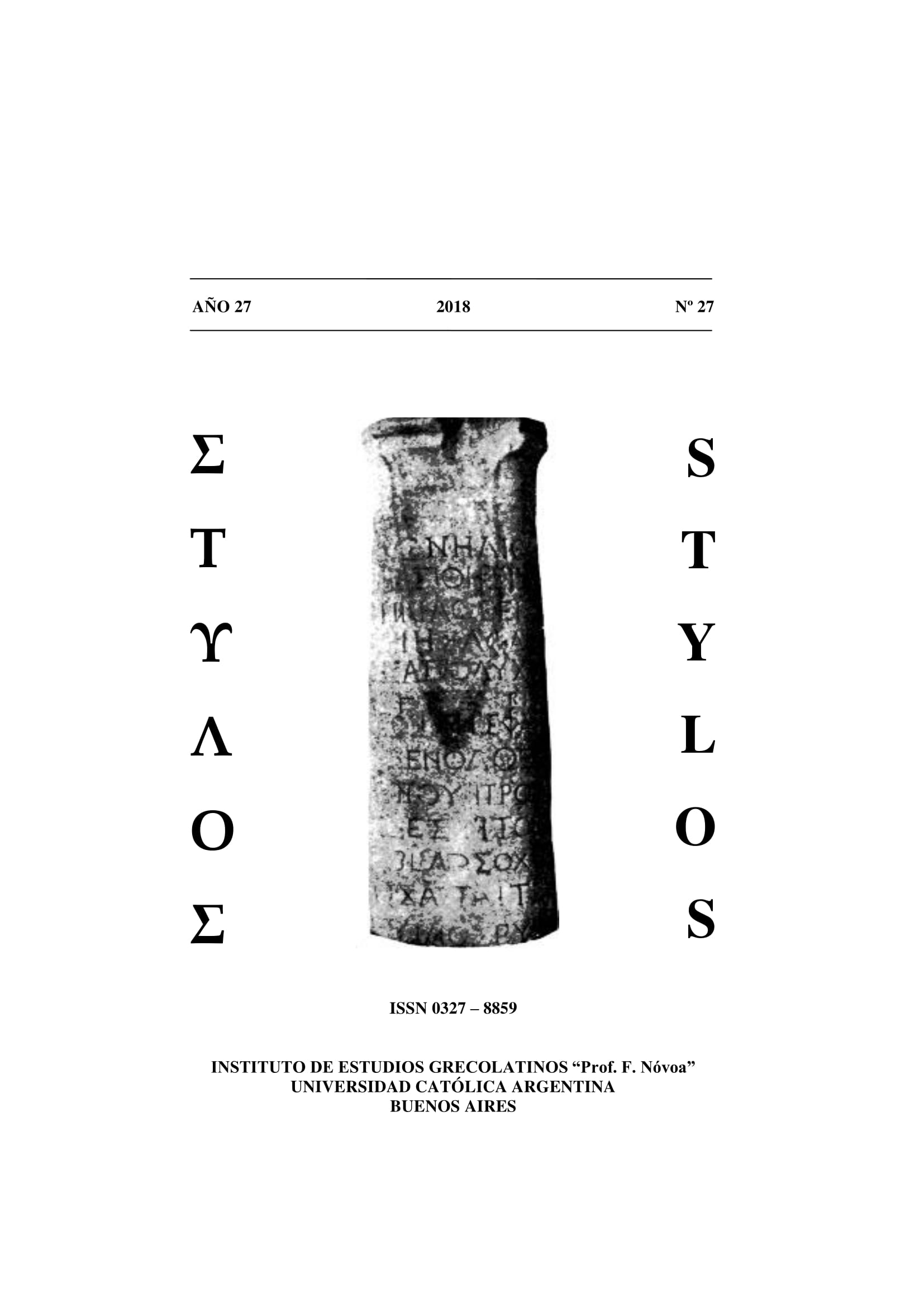EL PAR CÓMICO HOMÉRICO Y SU PROYECCIÓN SOBRE EL PAR CÓMICO ARISTOFÁNICO
Palabras clave:
Par cómico - Épica homérica - Comedia aristofánica - Héroe/antagonista - Burlador/burlado.Resumen
El trabajo intenta demostrar la existencia de un par cómico homérico, integrado por dos personajes opuestos y antagónicos, el burlador y el burlado, que constituyen el nudo semántico del episodio. El héroe es portavoz del discurso positivo y ocupa el lugar del vencedor y burlador de su oponente. La comedia aristofánica temprana se nutre del esquema homérico, entre otros antecedentes, para construir sus personajes protagonistas: el burlador y el burlado, el vencedor y el vencido, el portavoz del discurso avalado en la pieza y el portavoz del discurso atacado. Si bien Whitman (1964), entre otros, ha destacado los paralelismos entre Odiseo y el héroe aristofánico, no se ha analizado la incidencia del par homérico completo, el burlador y el burlado, sobre el par aristofánico. Nuestro trabajo desplaza el eje de análisis de la figura del héroe hacia el concepto de par cómico.Descargas
Citas
BELTRAMETTI, A. "Le couple comique. Des origines mythiques aux dé-rives philosophiques", 215-226. En: M.L. Desclos (ed.), Le rire des Grecs. Anthropologie du rire en Grèce ancienne, Grenoble: Editons Jérome Million, 2000.
BETA, S. Il linguaggio nelle commedie di Aristofane. Parola positiva e parola negativa nella comedia antica, Roma: Accademia Nazionale dei Lincei, 2004.
BRILLANTE, C. “La figura di Filocleone nel prologo delle Vespe di Aristofane”, QUCC, 1987; 26. 2: 23-35.
COOK, E. “‘Active’ and ‘Passive’ Heroics in the Odyssey”, 111-134. En: L.E. Doherty (ed.), Oxford Readings in Classical Studies. Homer's Odyssey, Oxford - New York: Oxford University Press, 2009.
DEGANI, E. “Aristofane e la tradizione dell'invettiva personale in Grecia”. 1-49. En: J.M. Bremen y E.W. Handley (eds.), Aristophane (Entre-tiens sur L’Antiquité Classique, XXXVIII), Vandoeuvres - Genève: Fondation Hardt, 1991.
DE LAMBERTERIE, CH. "Aristophane, lecteur d’Homère", 33-52. En: M. Trédé y Ph. Hof¬fman (eds.), Le rire des anciens. Actes du Colloque Internacional (Univer¬sité de Rouen, École normale supérieure, 11-13 janvier 1995), Paris: Presses de l'Ecole normale supérieure, 1998.
DE STE CROIX, G. E. M. “The Political Outlook of Aristophanes”, 42-64. En: E. Segal (ed.), Oxford Readings in Aristophanes, Oxford-New York: Oxford University Press, [1972] 1996.
DOVER, K. M. “Portrait-Masks in Aristophanes”, 155-169. En: H.-J. Newiger (ed.), Aristophanes und die alte Komödie, Darmstadt: Wis-senschaftliche Buch¬ges¬sellschaft, [1967] 1975.
DOVER, K. M. Aristophanic Comedy, Berkely-Los Ángeles: University of Ca¬li¬fornia Press, 1972.
FISHER, N. R. E. “Multiple Personalities and Dionysiac Festivals: Dicae¬o-polis in Aristophanes' 'Acharnians'”, G&R, 1993; 40. 1: 31-47.
FOLEY, H. “Tragedy and Politics in Aristophanes' Acharnians”, JHS, 1988; 108: 33-47.
FORREST, W. G. Aristophanes’ Acharnians, Phoenix, 1963; 17: 1-12.
GOLDHILL, S. The Poet’s Voice. Essays on Poetics and Greek Literature, Cam¬bridge: Cambridge University Press, 1991.
HALLIWELL, S. “The Uses of Laughter in Greek Culture”, CQ, 1991a; 41: 279-296.
HALLIWELL, S. “Comic Satire and Freedom of Speech in Classical Ath-ens”, JHS, 1991b; 111: 48-70.
HARRIOTT, R. M. "Acharnians 1095-1142. Word and actions", BICS, 1979; 26: 95-98.
HARRIOTT, R. M. “The Function of the Euripides Scene in Aristophanes' 'Achar¬nians'”, G&R, 1982; 29.1: 35-41.
HENDERSON, J. “Attic Old Comedy, Frank Speech, and Democracy”, 255-273. En: D. Boe¬de¬ker y K.A. Raaflaub (eds.), Democracy, Empire, and the Arts in Fifth-Century Athens, Cambridge-Massachusetts: Harvard University Press, 1998.
JOUAN, F. “La paratragédie dans les Acharniens”, Cahiers du Guita, 1989; 5: 17-30.
KEANE, C. “Definig the Art of Blame: Classical Satire”, 31-52. En: R. Quintero (ed.), A Companion to Satire, Oxford: Blackwell Publishing, 2007.
KENTCH, G. Euripidaristophanizing. Tragedy and Comedy in Four Plays of Aristophanes, Tennessee: VDM Verlag, 2008.
KERBRAT-ORECCHIONI, C. La enunciación. De la subjetividad en el len-guaje, Buenos Aires: Edicial, [1980] 1993 (trad. española G. Anfora y E. Gregores).
MARKS, J. “The Ongoing Neikos: Thersites, Odysseus, and Achilleus”, AJPh, 2005; 126: 1-31.
MASTROMARCO, G. “La maschera del miles gloriosus: dai Greci a Plauto”, 17-40. En: R. Raffaelli y A. Tontini (eds.), Lecturae Plautinae Sarsinates, XII, Miles gloriosus, Urbino: QuattroVenti 2009.
MCLEISH, K. The Theatre of Aristophanes, London: Thames and Hudson, 1980.
MONRO, D. B. Y ALLEN, TH. W. (eds.), Homero. Opera, Oxford: Oxford Cla¬ren¬don Press, [1902] 1939.
MOULTON, C. Aristophanic Poetry, Göttingen: Vandenhoeck und Ruprecht, 1981.
MURRAY, A. T. (ed.), Homer. The Odyssey, London: William Heinemann, 1919.
NAGY, G. The Best of the Achaeans. Conceps of the Hero in Archaic Greek Poetry, Baltimore-London: The Johns Hopkins University Press, 1979.
OLSON, D. S. (ed., com.), Aristophanes. Peace, Oxford: Oxford Clarendon Press, 1998.
OLSON, D. S. (ed., com.), Aristophanes. Acharnians, Oxford: Oxford Uni-ver¬sity Press, 2002.
¬ PADUANO, G. Il giudice giudicato. Le funzioni del comico nelle Vespe di Aristofane, Bologna: Il Mulino, 1974.
PLATTER, CH. Aristophanes and the Carnaval of Genres, Baltimore: The Johns Hopkins University Press, 2007.
RADIN, P. The Trickster. A Study in American Indian Mythology, New York: Schocken Books, [1956] 1972.
RAU, P. Paratragodia. Untersuchungen einer komischen Form des Aristophanes, München: C. H. Beck, 1967.
ROSEN, R. M. Making Mockery. The Poetics of Ancient Satire, Oxford: Oxford University Press, 2007.
SAETA COTTONE, R. Aristofane e la poetica dell’ ingiuria. Per una introduzione alla loidoría comica, Roma: Carocci Editori, 2005.
SEIDENSTICKER, B. Palintonos harmonia: Studien zu komischen Elemen-ten in der griechischen Tragodie, Göttingen: Vandenhoeck & Ruprecht, 1982.
SCHERE, M. J. “El par cómico de Estrepsíades y Sócrates en la comedia Nu¬bes de Aristófanes”, Argos, 2009; 32: 203-218.
SCHERE, M. J. “El tópico del burlador-burlado en la comedia Caballeros de Aristófanes”, Nova Tellus, 2013; 30. 2: 19-41.
SCHERE, M. J. “El par cómico en la fábula y su proyección sobre el par aristofánico”, Myrtia. Revista de Filología Clásica, 2014a; 19: 39-67.
SCHERE, M. J. “El problema del héroe cómico en Avispas”, Synthesis, 2014b; 21: 97-109.
SOMMERSTEIN, A. H. (ed., trad., com.), The comedies of Aristophanes. Peace, vol 5, Warminster: Aris & Phillips, [1985] 1990.
SOMMERSTEIN, A. H. “Comedy and the unspeakable”, 205-222. En: D.L. Cairns y R.A. Knox (eds.), Law, Rhetoric and Comedy in Classical Athens, Swansea: The Classical Press of Wales, 2004a.
SOMMERSTEIN, A. H. “Harassing the Satirist: The Alleged Attempts to Prosecute Aristophanes”, 145-174. En: I. Sluiter y R.M. Rosen (eds.), Free Speech in Classical Antiquity, Leiden-Boston: Brill, 2004b.
THALMANN, W. G. “Thersites: Comedy, Scapegoats, and Heroic Ideolgy in the Iliad”, TAPhA, 1988; 118: 1-22.
THIERCY, P. Aristophane: fiction et dramaturgie, Paris: Les Belles Lettres, 1986.
VOELKE, P. “Euripide, héros et poète comique: à propos des Acharniens et des Thesmophories d'Aristophane”, 117-138. En: C. Calame (ed.), Poétique d’Aristo¬pha¬ne et langue d’Euripide en dialogue, Lausanne: Études de Lettres, 2004.
WHITMAN, C. Aristophanes and the Comic Hero, Cambridge-Massachusetts: Harvard University Press, 1964.
WILSON, N. G. (ed.), Aristophanis Fabulae, vol. 1, Oxford: Oxford University Press, 2007.
Descargas
Publicado
Cómo citar
Número
Sección
Licencia






